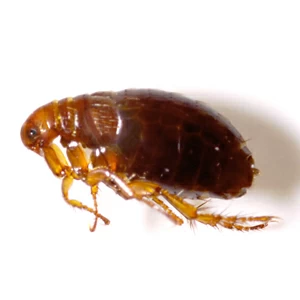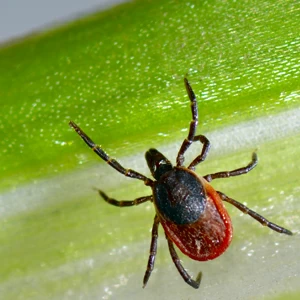


Bugging
You?
Fleas & Ticks
If you have enjoyed being outside in the warmer months with your pet or have hiked in the woods, you most likely have encountered fleas or ticks along the way, even while wearing flea and tick repellant. Both are parasitic, living on hosts larger than themselves. Both need to feed on the blood of their host and can transmit various diseases. They will hitch a ride on you or your pet, allowing them access to your living space where the problem festers. Fleas are brownish black to black but reddish black when full of blood.
Fleas and ticks prefer hairy animals such as dogs, cats, rodents, and squirrels but will look to you for a blood meal if the opportunity presents itself. They can jump 6 inches, and most are found nearby pet resting areas. Eggs are deposited between the hairs of the animal or on the bedding material and are easily shaken off. Ticks vary in color by species and are often found near wooded and highly vegetated areas. Adults crawl up on low vegetation, cling to it, and grasp onto any passing host.
Therefore, inspect yourself and your pet when returning from the outdoors. If ticks are attached to your skin, they should be grasped behind the head with tweezers and pulled slowly away from the skin. Do not just crush the tick, so more bacteria do not enter the puncture site. The mouthparts should also be removed, and the wound should be thoroughly washed and disinfected. Due to the complexity of what is required to eradicate the infestation, call Apex as soon as possible for flea and tick treatment!
Fleas & Ticks Identification
These parasitic pests are some of the most difficult to eradicate. Identification is the first step in removing any pest from your home or office. Fleas & ticks are more common than you think!

Cat Fleas
Identification Tips:
- Color: Brownish-black to black, but reddish-black when filled with blood
- Legs: 6
- Size: Adult fleas are 1/8 inches long
- Identifying Characteristics: Strong hind legs are used to jump from host to host; bodies are hardened and compressed from side to side.
Characteristics of this insect:
- Infestations get started in the summertime after pests come into contact with infested pets or while outside in infested areas
- Have piercing-sucking mouthparts, and they readily jump when trying to attach to a host (yes, people can be the host). Flea bites are extremely irritating to pets.
- Fleas undergo complete metamorphosis (egg, larva, pupa, adult). Adult males and females need a blood meal before mating. Females, which lays approximately 4-8 eggs after each blood meal, may lay up to 500 eggs during their lifetime. These eggs are deposited between the hairs of the animal and hence, are easily shaken off onto nearby surroundings.
- It can remain in the pupa stage for an extremely long period due to a lack of host or vibratory conditions. Adults emerge from the pupa state when stimulated by vibration and an increase in carbon dioxide, which indicates a host is present

Blacklegged Deer Tick
Identification Tips:
- Color: The body is orange-brown to reddish-brown, and the legs are dark reddish-brown to black
- Legs: 8
- Size: Unengorged adult female 1/8” long (male slightly smaller 1/16”)
Characteristics of this insect:
- Found primarily in the northeastern, mid-Atlantic, southeastern, and northcentral states in the United States, but extend into Mexico
- The preferred host is the white-tailed deer
- Of medical importance because it is an essential vector of Lyme disease, anaplasmosis, and babesiosis
- The life cycle (egg to egg) can be completed in 2 years in nature; it may be extended to 4 years if hosts are scarce.
- Females can deposit about 3,000 eggs which hatch in 48 to 135 days and can be found from June through September.

American Dog Tick
Identification Tips:
- Color: Brown with whitish to grayish markings, often with a silvery hue
- Legs: 8
- Size:Unengorged adult female 3/16” long (male slightly smaller 1/8”); engorged female is about 5/8”
Characteristics of this insect:
- Only found in North America
- Of medical importance because the vector of Rocky Mountain spotted fever and tularemia also causes tick paralysis
- Over 14 to 32 days lays egg masses totaling 4,000 to 6,500 yellowish-brown eggs and then dies.
- Can survive up to 540 days unfed
- Does not survive well indoors

Brown Dog Tick
Identification Tips:
- Color: Reddish-brown, but when engorged, engorged parts of the body change to gray-blue or olive color
- Legs: 8
- Size: Unengorged adults are about 1/8” but enlarge up to about ½” long when engorged with blood
Characteristics of this insect:
- Found throughout the United States and the world
- Most common species is usually encountered indoors
- Rarely attack humans, but can serve as vectors for Rocky Mountain spotted fever and several other disease organisms
- Drops off host dog, seeking shelter to lay her mass of typically 1,000-3,000 tiny, dark brown eggs
- Eggs hatch in 19-60; under favorable conditions, cycle can be completed in about 2 months but there are usually only 2 generations per year in the north and 4 in the south
- Does not do well in the outdoors; prefers warm, dry conditions where dogs live
